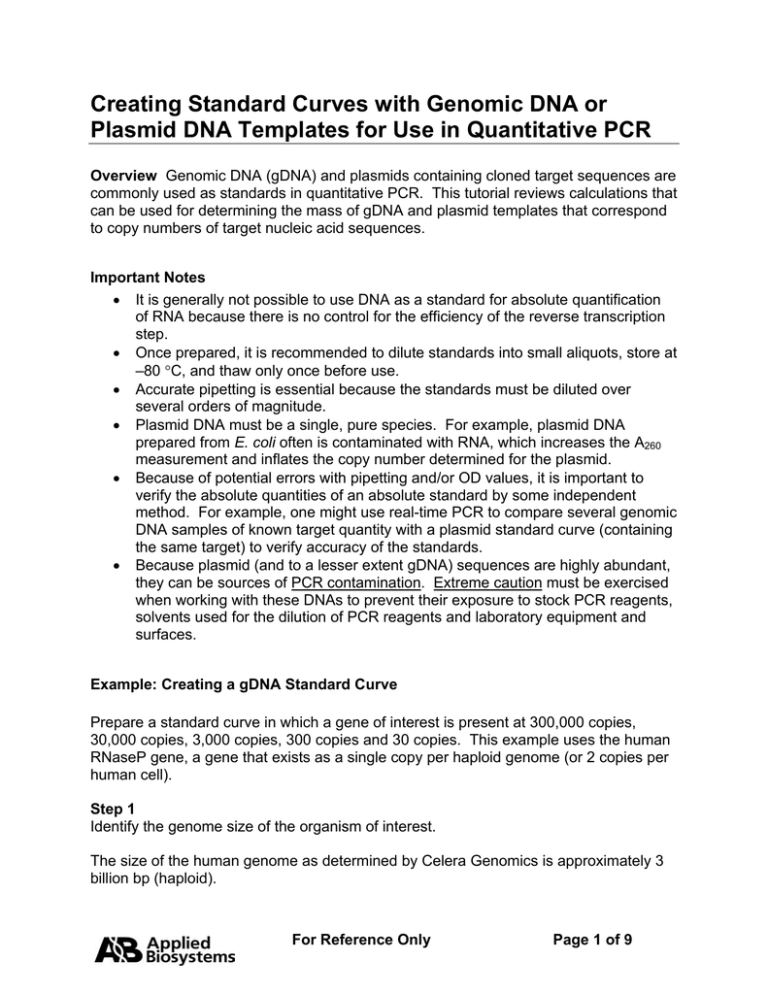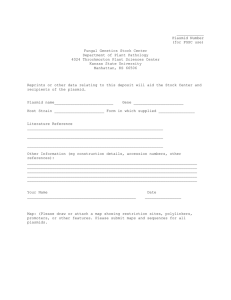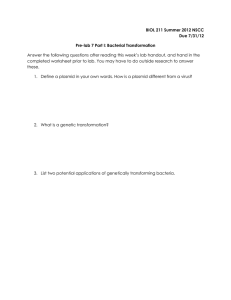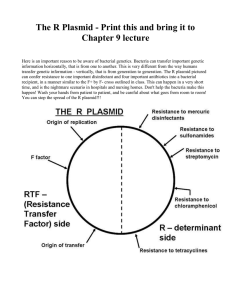
Creating Standard Curves with Genomic DNA or
Plasmid DNA Templates for Use in Quantitative PCR
Overview Genomic DNA (gDNA) and plasmids containing cloned target sequences are
commonly used as standards in quantitative PCR. This tutorial reviews calculations that
can be used for determining the mass of gDNA and plasmid templates that correspond
to copy numbers of target nucleic acid sequences.
Important Notes
• It is generally not possible to use DNA as a standard for absolute quantification
of RNA because there is no control for the efficiency of the reverse transcription
step.
• Once prepared, it is recommended to dilute standards into small aliquots, store at
–80 °C, and thaw only once before use.
• Accurate pipetting is essential because the standards must be diluted over
several orders of magnitude.
• Plasmid DNA must be a single, pure species. For example, plasmid DNA
prepared from E. coli often is contaminated with RNA, which increases the A260
measurement and inflates the copy number determined for the plasmid.
• Because of potential errors with pipetting and/or OD values, it is important to
verify the absolute quantities of an absolute standard by some independent
method. For example, one might use real-time PCR to compare several genomic
DNA samples of known target quantity with a plasmid standard curve (containing
the same target) to verify accuracy of the standards.
• Because plasmid (and to a lesser extent gDNA) sequences are highly abundant,
they can be sources of PCR contamination. Extreme caution must be exercised
when working with these DNAs to prevent their exposure to stock PCR reagents,
solvents used for the dilution of PCR reagents and laboratory equipment and
surfaces.
Example: Creating a gDNA Standard Curve
Prepare a standard curve in which a gene of interest is present at 300,000 copies,
30,000 copies, 3,000 copies, 300 copies and 30 copies. This example uses the human
RNaseP gene, a gene that exists as a single copy per haploid genome (or 2 copies per
human cell).
Step 1
Identify the genome size of the organism of interest.
The size of the human genome as determined by Celera Genomics is approximately 3
billion bp (haploid).
For Reference Only
Page 1 of 9
If the genome size of the organism of interest is not readily available, go to
http://www.cbs.dtu.dk/databases/DOGS/index.html
and select the appropriate database. Below is an excerpt from the
“Abbreviated database (By name)”
Size of human
genome
(haploid)
The estimate of 3,400,000,000 bp, or 3.4e9 bp (haploid), is consistent with Celera’s
estimate of 3,000,000,000 bp or 3.0e9 bp (haploid).
Step 2
Identify the mass of DNA per genome
Calculate the mass of the genome by inserting the genome-size value in the formula
below (see page 8 for derivation of this formula).
m = n
1.096e-21 g
bp
where: n = genome size (bp)
m = mass
e-21 = ×10-21
The mass of the human genome (haploid) is calculated as follows.
m = 3.0e9 bp
1.096e-21 g = 3.3e−12 g
bp
The calculation below converts the mass to picogram units.
3.3e-12 g
1e12 pg = 3.3 pg
g
Step 3:
Divide the mass of the genome by the copy number of the gene of interest per haploid
genome.
The RNase P gene is a target that exists as a single copy gene per haploid genome (or
2 copies per human cell).
3.3 pg/genome ÷ 1 copy RNase P/genome = 3.3 pg
genome
For Reference Only
genome =
3.3 pg
1 copy
1 copy RNase P
Page 2 of 9
Therefore, 3.3 pg of human gDNA contains one copy of the RNase P gene.
Step 4
Calculate the mass of gDNA containing the copy #s of interest, that is 300,000 to 30
copies.
Copy # of interest × mass of haploid genome = mass of gDNA needed
Copy #
300,000
30,000
3,000
300
30
Mass of gDNA
needed (pg)
990,000
99,000
9,900
990
99
× 3.3 pg
Step 5
Calculate the concentrations of gDNA needed to achieve the copy#s of interest. Divide
the mass needed (calculated in Step 4) by the volume to be pipetted into each reaction.
In this example, 5µL of gDNA solution will be pipetted into each PCR reaction.
Calculate the concentration of gDNA needed to achieve the required masses of gDNA.
Copy #
300,000
30,000
3,000
300
30
Mass of gDNA
needed (pg)
990,000
99,000
9,900
990
99
÷ 5 µL
Final concentration
(pg/µl) of gDNA
198,000
19,800
1,980
198
19.8
Step 6
Prepare a serial dilution of the gDNA.
For the dilutions we will use the formula,
C1V1 = C2V2
The stock concentration of human gDNA was determined by spectrophotometric
analysis to be 1.2 µg/µl. Therefore, in this example, C1 = 1.2 µg/µL or 1,200,000 pg/µL.
Each dilution prepared has a final volume (V2) of 100µL.
For Reference Only
Page 3 of 9
Dilution #1
1,200,000 pg V1
µL
= 198,000 pg
µL
100 µL
V1 = 16.5 µL
Volume of diluent = 100 µL – 16.5 µL = 83.5 µL
To achieve the final volume of 100 µL, add 16.5 µL of stock gDNA to 83.5 µL of diluent.
Note: The diluent can be sterile 1X TE (1mM Tris, 0.1mM EDTA, pH8.0) or sterile,
nuclease-free H2O.1
Dilutions 2 to 5 were calculated using the same types of calculations (C1V1 = C2V2) as
presented above for Dilution #1.
The following table presents the calculated volumes of gDNA and diluent for all 5
dilutions.
Dilution
#
Source
of
gDNA
for
dilution
1
2
stock
Dilution
1
Dilution
2
Dilution
3
Dilution
4
3
4
5
Initial
concentration
(pg/µL)
Volume
of
gDNA
(µL)
Volume
of
diluent
(µL)
C1
1,200,000
198,000
V1
16.5
10
19,800
Final
Volume
(µL)
Final
concentration
of dilution
(pg/µl)
83.5
90
V2
100
100
C2
198,000
19,800
300,000
30,000
10
90
100
1,980
3,000
1,980
10
90
100
198
300
198
10
90
100
19.8
30
Resulting
copy #
RNase P
gene/ 5µl
1
It is the users responsibility to determine whether the use of background nucleic acid will impact assay
performance (ex. PCR efficiency). Background nucleic acid is DNA or RNA that can be spiked into the
standard so as to mimic the biological unknown samples.
For Reference Only
Page 4 of 9
Example: Creating a Standard Curve with a Plasmid DNA Template2
Background
Prepare a standard curve in which the cloned ß-actin sequence is present at 300,000
copies, 30,000 copies, 3,000 copies, 300 copies and 30 copies. The plasmid size is
15,000 bp. The stock of plasmid DNA was determined to be 2.0 µg/µL by
spectrophotometric analysis. The PCR reactions are set-up such that 5µL of plasmid
DNA are pipetted into each PCR reaction.
Step 1
Calculate the mass of a single plasmid molecule.
Insert the plasmid size value into the formula below (see page 8 for derivation of this
formula):
m = n
1. 096e-21 g
bp
where: n = plasmid size (bp)
m = mass
e-21 = ×10-21
Note: Use the size of the entire plasmid (plasmid + insert) in the calculation above
instead of the size of the insert alone.
Mass of one plasmid molecule= 15,000 bp
1.096e-21 g =
bp
1.64e-17 g
Step 2
Calculate the mass of plasmid containing the copy #s of interest, that is 300,000 to 30
copies.
Copy # of interest × mass of single plasmid = mass of plasmid DNA needed
For example, mass of plasmid DNA containing 300,000 copies of B-actin sequence is
as follows.
1.64e-17 g
copy
300,000 copies
= 4.92e-12 g
2
It is the users responsibility to determine whether linearization of the plasmid standard with a restriction
endonuclease will impact assay performance (ex. PCR efficiency).
For Reference Only
Page 5 of 9
The following table presents the calculated plasmid masses needed to achieve the copy
numbers of interest.
Copy #
300,000
30,000
3,000
300
30
Mass of plasmid
DNA (g)
4.92e-12
4.92e-13
4.92e-14
4.92e-15
4.92e-16
× 1.64e-17 g
Step 3
Calculate the concentrations of plasmid DNA needed to achieve the copy#s of interest.
Divide the mass needed (calculated in Step 2) by the volume to be pipetted into each
reaction.
In this example, 5µL of plasmid DNA solution is pipetted into each PCR reaction.
Calculate the concentration of gDNA needed to achieve the required masses of gDNA.
Copy #
300,000
30,000
3,000
300
30
Mass of plasmid
DNA needed (g)
4.92e-12
4.92e-13
4.92e-14
4.92e-15
4.92e-16
÷ 5 µL
Final concentration of
plasmid DNA (g/µL)
9.84e-13
9.84e-14
9.84e-15
9.84e-16
9.84e-17
Step 4
Prepare a serial dilution of the plasmid DNA.
Cloned sequences are highly concentrated in purified plasmid DNA stocks. A series of
serial dilutions must be performed to achieve a working stock of plasmid DNA for
quantitative PCR applications. The table on page 7 shows that the first 3 dilutions (each
1:100) were prepared so that the plasmid would be at a workable concentration, that is
2e-12 grams/µL or 1.32e5 copies/µL.
Once the plasmid is at a workable concentration, use the following formula to calculate
the volume needed to prepare the 300,000 copy standard dilution (Dilution #4).
C1V1 = C2V2
For Reference Only
Page 6 of 9
Dilution #4
(see table below for C1 ,C2,V1 and V2 values)
2e-12 g
µL
V1
=
100 µL
9.84e-13 g
µL
V1 = 49.2 µL
Volume of diluent = 100 µL – 49.2 µL = 50.8 µL
To achieve the final volume of 100 µL, add 49.2 µL of stock gDNA to 50.8 µL of diluent.
Note: The diluent can be sterile 1X TE (1mM Tris, 0.1mM EDTA, pH8.0) or sterile,
nuclease-free H2O. 3
Dilution #
Dilutions 5 to 8 were calculated using the same types of calculations as Dilution #4
above.
1
2
3
4
5
6
7
8
Source of
plasmid
DNA for
dilution
stock
Dilution 1
Dilution 2
Dilution 3
Dilution 4
Dilution 5
Dilution 6
Dilution 7
Initial
conc.
(grams/µL)
Volume
of
plasmid
DNA
(µL)
C1
2e-06
2e-08
2e-10
2e-12
9.84e-13
9.84e-14
9.84e-15
9.84e-16
V1
10 µl
10 µl
10 µl
49.2 µl
10 µl
10 µl
10 µl
10 µl
Volume of
diluent
(µL)
990 µl
990 µl
990 µl
50.8 µl
90 µl
90 µl
90 µl
90 µl
Final
Volume
(µL)
V2
1000 µl
1000 µl
1000 µl
100 µl
100 µl
100 µl
100 µl
100 µl
Final conc.
in
(g/µl)
Resulting
copy # of
ß-actin
sequence /
5 µl
C2
2e-08
2e-10
2e-12
9.84e-13
9.84e-14
9.84e-15
9.84e-16
9.84e-17
N/A
N/A
N/A
300,000
30,000
3,000
300
30
In the example above, dilutions 4 to 8 would be used for the quantitative PCR
application.
3
It is the users responsibility to determine whether the use of background nucleic acid will impact assay
performance (ex. PCR efficiency). Background nucleic acid is DNA or RNA that can be spiked into the
standard so as to mimic the biological unknown samples.
For Reference Only
Page 7 of 9
Derivation of DNA Mass Formula
m = n
1.096e-21 g
bp
The formula above was derived as follows
m =
n
1 mole
6.023e23 molecules (bp)
660 g
mole
=
n
1.096e-21 g
bp
where:
n = DNA size (bp)
m = mass
Avogadros number = 6.023e23 molecules / 1 mole
Average MW of a double-stranded DNA molecule = 660 g/mole
For Reference Only
Page 8 of 9
2003. Applied Biosystems. All rights reserved.
For Research Use Only. Not for use in diagnostic procedures.
The PCR process is covered by patents owned by Roche Molecular Systems, Inc. and
F. Hoffmann-La Roche Ltd.
Applied Biosystems is a registered trademark and AB (Design), Applera, Celera and
Celera Genomics are trademarks of Applera Corporation or its subsidiaries in the US
and/or certain other countries.
For Reference Only
Page 9 of 9







